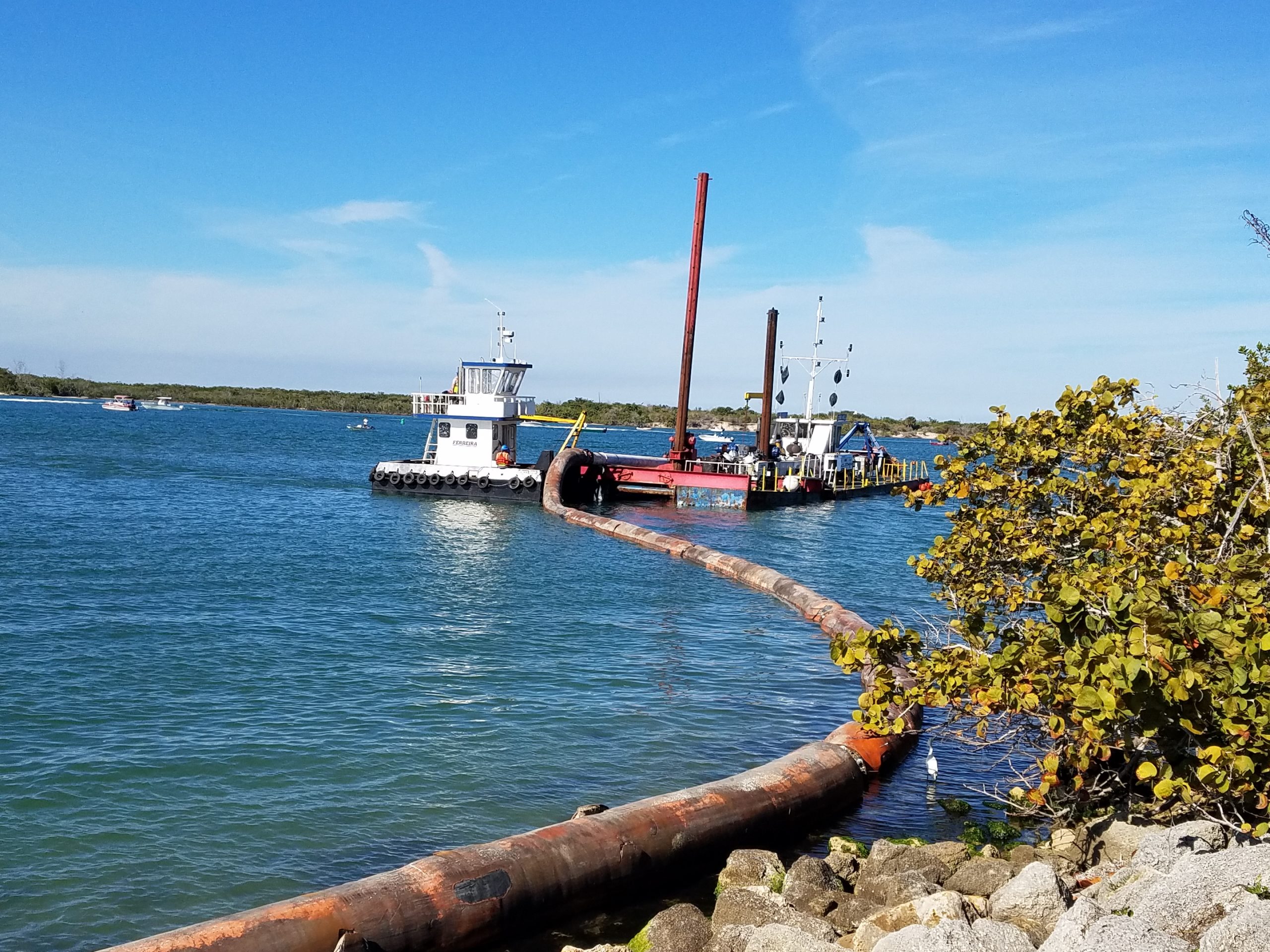Dredging operations to remove approximately 150,000 cubic yards of sand from the Sebastian Inlet in Florida began January 21. Ferreira Construction of Stuart, Florida, has been using its 18-inch hydraulic dredge, Lori Hill equipped with Hypack software, to remove sand from the inlet’s sand trap and navigation channel. The material is being placed in two locations with 120,000 cubic yards being pumped onto a one and half mile stretch of beach. Ferreira will pump the remainder to the Sebastian Inlet District’s Dredged Material Management Area (DMMA). The seven-acre DMMA stockpiles sand for use in emergency beach fill and dune repair operations.
According to Michael Ciabatteri, project manager for Ferreira, sand is moving through about 18,000 feet of 18-inch HDPE pipe with the two inline boosters, a 16- and an 18-inch, one placed under a bridge and one on the beach. The company is also using a barge with a mounted excavator, two dozers and another excavator on the land.
“Staging for the project began right before Christmas. It took about 35 days to fuse all the pipe and mobilize the equipment,” Ciabatteri said. Close to 22 people are working on the project.

The first step is dredging the sand trap, which is a 42-acre depression that fills with sand. It’s located between the flood shoal on the west side of the inlet and the inlet throat. According to Mike Jenkins, engineer of record for the project and coastal engineering principal with Applied Technology and Management, the sand trap is the result of the construction of the manmade inlet.
Legislation was passed in 1919 to construct the Sebastian Inlet. At this time the Sebastian Inlet District was also formed by an act of the Florida State legislature to be an independent special district chartered to maintain the navigational channel between the Atlantic Ocean and the Indian River. The district commission oversaw the construction of the inlet, which was completed in the 1950’s.
“Once it was functioning, they saw impounding sand on the north and no sand getting to the south. The issue grew. In the early ‘60’s the University of Florida studied the problem and they came up with the idea of a sand trap to capture the sand lost from the beach, and then it could be pumped back to the beach where it would have gone naturally if the inlet wasn’t built,” Jenkins said.
This became the first inlet management plan in Florida. By law, inlets in Florida must be managed to mitigate the impacts to downward beaches.
“A study done by the University of Florida found that just on the east coast of Florida, more than 90 percent of the erosion impacts on the beaches come from the stabilized inlets. The law requires that the sand be put back on the beaches,” Jenkins said.
For this project the beaches will be widened by about 50 feet, and dunes will be replenished. Jenkins said smaller nourishment projects are undertaken in this area, about once every three to five years, to better mimic what would happen naturally for erosion and replenishment of sand if the inlet wasn’t there.
Once the sand trap dredging is complete, estimated to be in mid-March, dredging of the navigation channel will begin. All work is slated for completion sometime in April.
Monitoring and Data Collection
Monitoring of the Sebastian Inlet is comprehensive. The Sebastian Inlet District in partnership with the Florida Institute of Technology consistently collects data to monitor the accumulation of sand within the inlet system and conduct semi-annual bathymetric surveys.
“The surveys give a measurement of the rate sand is moving through the system and ensures the stability of the downdrift beaches. Management decisions are based on this data. They also measure waves, water levels and sand volumes on the beaches. It’s a very comprehensive science program and comprehensive environmental program that was partially required under the permit but was expanded by the inlet district to better understand the health of the inlet,” Jenkins said.

He further clarified that the Sebastian Inlet is the main area of water exchange for the Indian River Lagoon, which is the most diverse estuary in the United States.
“What’s a little different about this project is that we’re getting monitoring assistance from the Florida Institute of Technology,” Ciabatteri said.
During the dredging process the Florida Institute of Technology is working with Ferreira to conduct ongoing turbidity monitoring around the dredge and at the ocean side discharge point. The monitoring is required by the Florida Department of Environmental Protection standards to protect seagrass shoals to the west of the inlet and nearshore hardbottom along the southern beaches.
Immediately after project completion, marine biologists with CSA Ocean Sciences, who conducted a comprehensive, pre-project nearshore hardbottom survey this summer, will go in to conduct a post- project survey to ensure no sand has migrated to cover the nearshore hardbottom habitat. The last 10 years of environmental monitoring show no impacts from Sebastian Inlet District projects.
The $2,945,000 project is being paid for through cost share funding available through the Florida Department of Environmental Protection and earmarked by the Florida State Legislature for coastal and inlet management. That fund is providing 75 percent of the cost, while the Sebastian Inlet District is providing the remaining 25 percent.
More than 2.5 million cubic yards of sand has been placed during beach restoration projects in the Sebastian Inlet District’s almost 100-year history.




